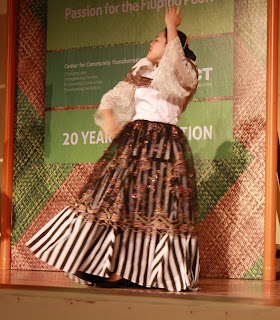The CCT Dance Troupe, composed of staff from the head office and branches in the national capital region, presented a series of colorful regional dances during the first evening of the weeklong CCT 20th anniversary celebration in Tagaytay.
 |
From the Cordilleras in Luzon comes Ragragsakan
portraying Kalinga maidens gathering food
which is placed in big baskets balanced
on top of the head. |
 |
The Salip dance, also of the Kalinga tribe, depicts a
warrior claiming his bride by presenting her with a
matrimonial blanket. The woman responds
by balancing several claypots on her head.
She follows the man to connote obedience. He
simulates the movement of a rooster
aspiring to attract and sieze his love.
A version of this love dance has two warriors
competing for the approval of the fair maiden. |
 |
Jota de Manila, a dance of Spanish origin named
after the historic city of Manila. |
 |
From the Visayas comes Bulaklakan, a dance
usually performed in May
and featuring handheld arches decorated
with multicolored flowers. |
 |
Hariraya, the flag dance, is from Mindanao.
Colorful banners are displayed in homes and
public places during this festival. |
 |
Here and in next two photos, colorful and richly
decorated umbrellas are displayed in the
Kinakalungan dance. |
 |
Here and in next four photos,
dancers demonstrate the
different styles of wearing
the Kumbong, a veil or
head scarf worn by women |
 |
Paunjalay, a dance performed by a Yakan couple
before they are wed. This dance is also performed
during wedding feasts as a form of
entertainment. |
 |
| Karasaguyon, a T'boli courtship dance |
 |
Singkil, here and in next four photos. The singkil dance
takes its name from the bells worn on the ankles of the
Muslim princes. It tells the epic legend of the
Maranao people, the Darangan. The tale
is about Princess Gandingan
who was caught in the middle of the forest
during an earthquake caused by the
fairies of the forest. The crisscrossed
bamboo poles represent falling trees which she
gracefully avoids. Her slave loyally accompanies her
throughout her ordeal. Finally, she is saved by a
prince. Royal pricessess to this day in the Sulu
archipelago are required to learn this difficult and
noble dance. |
Reportage: Ping Alegria; photos: Ciara Tan





























Nice Guys
ReplyDelete